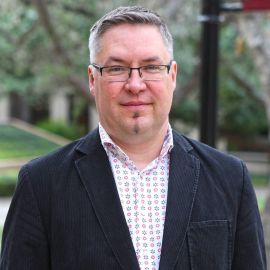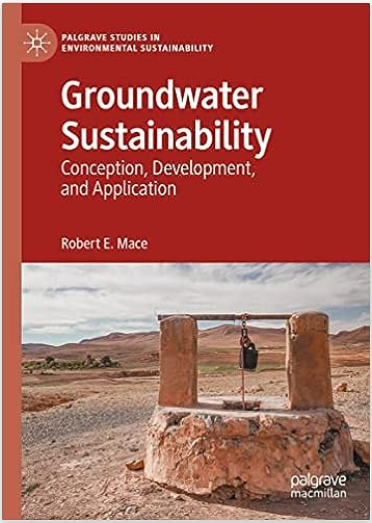Listen here on Spotify | Listen here on Apple Podcast
Episode recorded July 6, 2023
Episode released on October 5, 2023
 Dr. Robert Mace is the Executive Director at the Meadows Center for Water and the Environment and Professor of Practice in Dept. of Geography and Environmental Studies at Texas State University. His research focuses on bridging the gap between science and policy, emphasizing sustainable groundwater management.
Dr. Robert Mace is the Executive Director at the Meadows Center for Water and the Environment and Professor of Practice in Dept. of Geography and Environmental Studies at Texas State University. His research focuses on bridging the gap between science and policy, emphasizing sustainable groundwater management.
Highlights | Transcript
- Robert published “Groundwater Sustainability: Conception Development and Application” in January 2023 (Palgrave MacMillan) (Fig. 1). The book provides historical context for many of the concepts related to sustainability and examples from various aquifers (e.g., Ogallala, Edwards, Trinity in Texas). Technical aspects of groundwater are explained for non-specialists and is well illustrated.
- Communicating science to policy makers is critical and use of acronyms is a real deterrent to communication. Robert avoids all use of acronyms.
- Texas provides an excellent field lab for groundwater sustainability with climate ranging from arid in West Texas to humid in East Texas and variety of aquifer types and differences in historical development.
- Current conditions in Texas: coming out of 3-yr drought (2021 – 2023) likely associated with La Nina conditions, not as bad as 2011 – 2015 drought in Texas (Fig. 2). Edwards Aquifer is currently in hydrologic drought, San Marcos springs has markedly declined to lowest levels since 1950s drought and J17 indicator well is very low.
- Need floods to end extreme droughts, e.g. Wimberley floods in 2015 ended 2011 – 2015 drought. Earlier rains primed the pump by increasing soil moisture.
- Early sustainability concepts for groundwater derived from surface water management. Safe yield concept first mentioned in 1915, maximizing production for benefit of people. In Texas, the term “firm yield” is used. These concepts refer to how much water you can produce indefinitely without causing dangerous impacts.
- Environmental impacts started to be considered in the 1970s.
- Safe yield is a policy question informed by science.
- Mace adopts Alley (1999) definition of sustainable yield: development and use in a manner that can maintain an aquifer for an infinite time without causing unacceptable environmental, economic, or social consequences.
- Mace (2023) includes an excellent description of unconfined and confined aquifers and implications for management.
- Unconfined aquifers such as the Ogallala Aquifer derive water for pumping by draining the pore space and result in localized cones of depression. They are well connected to surface water and overexploitation reduces spring flow and streamflow.
- Confined aquifers, such as the Trinity Aquifer derive water for pumping from aquifer and water compressibilities and reduce the pressure in the aquifer with pumpage. Pressure pulse from overexploitation propagated widely. The Trinity Aquifer originally had flowing artesian wells in Dallas/Fort Worth region in the late 1800s early 1900s, water supply considered limitless. However, wells stopped flowing in early to mid-1900s as pressure was depleted. Overexploitation in early-1900s for municipal water supply resulted in 1000 ft drawdown in the Trinity Aquifer (Fig. 3).
- Edwards Aquifer, overexploitation and depletion avoided by Endangered Species Act in the 1970s and creation of Edwards Aquifer Authority.
- Groundwater depletion in Texas gateway drug to development: people often overexploit groundwater initially and then switch to more centralized surface water supplies when feasible (e.g., Trinity Aquifer, Dallas/Fort Worth; Gulf Coast Aquifer, Houston).
- Groundwater depletion in Houston area resulted in subsidence, creation of Houston-Galveston Subsidence District and switched to surface water.
- Solutions to water management: example Austin’s Water Forward, 100 yr integrated water plan.
- Projected population growth in Austin proper: 1 million to 4 million in 2115.
- Colorado River water supplies projected to decline by 50% by 2100 due to climate change
- Plan includes:
- reducing demand (conservation, metering, water efficient landscapes, rainwater harvesting, stormwater, wastewater, graywater, AC condensate), totaling 102,000 afy 2115.
- increasing supplies (brackish groundwater desalination; direct potable reuse, indirect nonpotable reuse, distributed wastewater, drought supply strategies) totaling 130,000 afy/2115
- storing water from wet to dry periods (Aquifer Storage and Recovery, 60,000 af/yr [2115] and a new off-channel reservoir, 25,000 af/yr, 2115)
- This portfolio of options is designed to increase resilience of water supplies, similar to approaches adopted by San Antonio where they have stored ~200,000 af (~ 4× Austin’s annual water use)
- Robert is optimistic about the future and glad we have the Gulf of Mexico as a potential source for desalination.
- Future book: Beyond a Reasonable Drought about climate change.





